“One Health” and Wildlife
By Lori Swanson, Director of Wildlife Rehabilitation
 The COVID-19 pandemic and the more recent outbreak of Highly Pathogenic Avian Influenza (HPAI) has made us all think more profoundly about how our lives can be affected by the health of animal populations and the environment. While the general public has more recently been taking notice of this interconnectedness, human health professionals, animal healthcare workers, and environmental experts have been focused on this for many years. As professionals who work hands-on with native New Jersey wildlife, our licensed Wildlife Rehabilitators are acutely aware that our patients can bring with them a host of parasites and diseases that could negatively affect our health if proper precautions are not taken.
The COVID-19 pandemic and the more recent outbreak of Highly Pathogenic Avian Influenza (HPAI) has made us all think more profoundly about how our lives can be affected by the health of animal populations and the environment. While the general public has more recently been taking notice of this interconnectedness, human health professionals, animal healthcare workers, and environmental experts have been focused on this for many years. As professionals who work hands-on with native New Jersey wildlife, our licensed Wildlife Rehabilitators are acutely aware that our patients can bring with them a host of parasites and diseases that could negatively affect our health if proper precautions are not taken.
Health professionals have coined this movement as “One Health”, a term that was developed in 2003 when the SARS outbreak was found to be affecting several wild animal species as well as humans. The effect of the 2004 outbreak of H5N1, avian influenza, on

our food supply further solidified a more universal recognition that wildlife and environmental health can greatly impact humans physically and economically. One Health became an initiative worldwide to bring together professionals from the three main disciplines of human health, animal health, and environmental experts to work together towards a healthier future.
In Wildlife Rehabilitation, most of the reasons for animal intakes are related to human interaction, whether the animal was hit by a car, hit a window, was orphaned after their mother was relocated or displaced, hit by a lawnmower, caught by a cat, etc. We recognize, as does One Health, that human population expansion into wild lands causes closer contact with wildlife and more actual interaction. Humans are traveling worldwide, bringing them in contact with many different and exotic species of wild animals. Additionally, habitat alterations and loss can affect wildlife populations and allow for more disease spread. All of these things make it easier for disease to potentially spread from animal to human, human to animal, or human to human on a global scale.
Diseases that spread between animals and humans are known as zoonotic diseases and include things such as rabies, leptospirosis, West Nile Virus, raccoon roundworm, tularemia, ringworm, etc. Humans can also transfer diseases to other animals such as COVID-19 and HPAI. Our Wildlife Rehabilitators at Cedar Run work very closely with wildlife and take the potential for disease transfer extremely seriously, protecting themselves with PPE during all interactions with their patients. The general public who handle animals to bring to us for care are also advised to use protective PPE and to not personally care for wildlife, which helps them to avoid the transfer of disease or parasites to themselves, their family, their pets, and the wild animal. Taking note of zoonotic diseases in Wildlife Rehabilitation can also help to catch emerging diseases quickly and be an early warning sign of potential human illness.
The decisions that we make handling wildlife affect not only us and the individual animal but also have the potential to affect larger populations. One Health is an approach that we should all factor into our lives as we share this planet alongside our wildlife and domestic animal species. Opening our minds to understand and accept that the health of other species, ourselves, and our environment are interconnected can protect global health, slow or stop the spread of diseases, and protect the biodiversity of our planet.
To find out more about One Health and its associated projects, visit cdc.gov/onehealth


